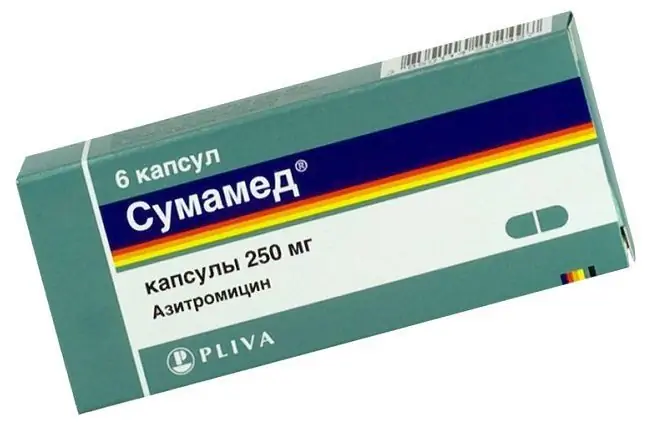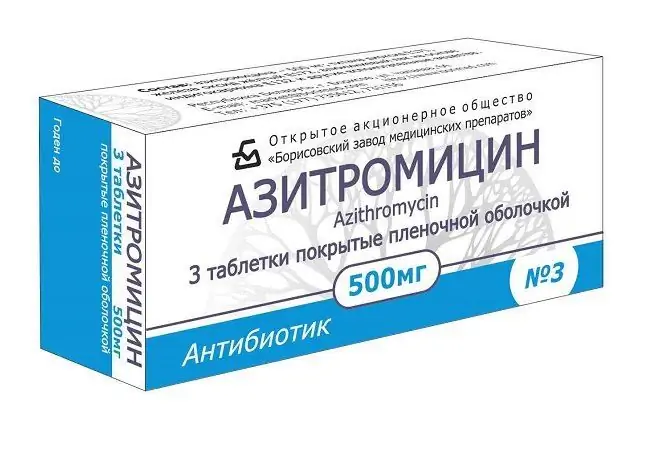- Author Rachel Wainwright [email protected].
- Public 2023-12-15 07:39.
- Last modified 2025-11-02 20:14.
Sumamed for angina in adults and children: method of application, side effects
The content of the article:
- Antibiotic therapy for angina
- Pharmacodynamic and pharmacokinetic properties of Sumamed
- Contraindications to taking Sumamed
- Mode of application
- Possible side reactions
- Antibacterial drug intake rules
- Video
Sumamed for angina in adults and children is often included in the main treatment regimen. Angina, or acute tonsillitis, is a common infectious disease characterized by an acute inflammatory process that affects the tonsils. Etiological agents are viruses, bacteria, fungi.

Sumamed is often prescribed for the treatment of angina in adults and children.
Sumamed is a broad-spectrum antibacterial drug. It contains the active ingredient - azithromycin, which belongs to the group of macrolides-azalides and has a bacteriostatic effect.
Macrolides act as both main and backup antibiotics in the treatment of angina. They are the drugs of choice for a prolonged, severe course of the disease, as well as in the presence of intolerance to antibacterial agents of the penicillin series and cephalosporins.
The drug is included in the first line of antibiotics during an exacerbation of chronic angina, in which pathogens resistant to standard antibacterial agents are often found.
Antibiotic therapy for angina
Angina is manifested by severe sore throat, inability or difficulty in swallowing hard and soft food, water, saliva due to pain, fever up to febrile numbers, chills, headache, joint and muscle pain, hyperemia and edema of the mucous membrane of the palatine arches, palatine tonsils, soft palate, fibrinous or purulent plaque on the palatine tonsils, as well as painful enlargement of regional lymph nodes. The spread of inflammation with the appearance of pharyngitis, laryngitis is possible.

Antibiotics should only be prescribed for bacterial etiology of sore throat
In the etiology of angina, the leading role is played by group A beta-hemolytic streptococcus, which not only causes severe inflammation of the lymphoid tissue of the tonsils, but also often leads to various infectious and rheumatic complications in both adults and children. These include:
- rheumatism;
- glomerulonephritis;
- carditis;
- retropharyngeal or paratonsillar abscess;
- mediastinitis;
- pyelonephritis.
It is important to remember that antibiotic therapy is necessary only for bacterial damage to the tonsils, since antibiotics are useless for viral or fungal sore throat.
The outcome of the disease, with or without complications, depends on the correct choice of medicine. Therefore, when the above symptoms of the disease appear, it is necessary to consult a doctor in a timely manner - an infectious disease specialist, an otorhinolaryngologist or a therapist - for examination and determination of treatment tactics.
Pharmacodynamic and pharmacokinetic properties of Sumamed
The mechanism of action of azithromycin in the antibiotic Sumamed is to suppress protein synthesis of the microbial cell. After binding to the 50S-subunit of the ribosome, inhibition of peptide translocase occurs at the translation stage, which leads to suppression of protein synthesis, slowing down the growth and reproduction of bacteria.

Azithromycin belongs to the group of macrolides-azalides
In high concentrations, azithromycin has a bactericidal effect.
The spectrum of action of the antibiotic includes gram-positive, gram-negative, anaerobic and intracellular microorganisms: staphylococci, group A, B, C, G streptococci, pneumococcus, Haemophilus influenzae, gonococci, chlamydia, mycoplasma, fusobacteria.
The resistance of bacteria to azithromycin, according to different authors, is 10-20%. The drug is well absorbed and quickly distributed in the body, transported by phagocytes to the site of infection, and concentrated in tissues and cells. Due to its ability to penetrate membranes, the effectiveness of azithromycin against intracellular pathogens increases.
Sumamed has a very long half-life, which ranges from 35 to 50 hours or more. The therapeutic concentration of azithromycin lasts up to 5-7 days after the last dose.
The substance is excreted unchanged through the intestines and kidneys.
The interaction of an antibiotic with other drugs in most cases does not affect the absorption and concentration of simultaneously prescribed drugs, but it is important to warn the doctor about all drugs taken.
According to reviews, Sumamed relieves angina in a few days. Pain syndrome quickly stops, body temperature decreases, edema and inflammation of the mucous membrane of the palatine tonsils and oropharynx is resolved, purulent discharge stops.
Contraindications to taking Sumamed
Contraindications to the appointment of Sumamed are:
- severe liver and kidney dysfunction;
- children under 3 years old;
- pregnancy and the period of breastfeeding;
- hypersensitivity or intolerance to macrolide antibiotics.
Mode of application
The drug is taken orally 1 hour before or 2 hours after meals. The dispersible tablet can be swallowed whole with water or dissolved in 50 ml of water. The resulting suspension must be thoroughly mixed before taking.

Sumamed is taken orally with water, or a tablet is dissolved in 50 ml of water
The severity of the condition often determines how much you need to take the medicine.
In most cases, the drug is prescribed for adults 1 tablet per day for 3 days.
The dosage of Sumamed for angina in children is calculated by the attending physician individually, depending on body weight: 20 mg per kg, drink 1 time per day for 3 days. The dose for the course of treatment is 60 mg per kg of body weight.
If you miss one dose of Sumamed, it should be taken as soon as possible, and the next one after 24 hours.
While taking an antibiotic, it is considered necessary to use complex agents containing lactobacilli and bifidobacteria (probiotics and prebiotics), which are designed to help restore or preserve the intestinal microflora. Often prescribed drugs Linex or Bifidumbacterin 1-2 capsules 2 times a day for two weeks.
Possible side reactions
Like any other drug, Sumamed can cause side effects from various organs and systems, including allergic reactions in the form of urticaria or angioedema. Therefore, a specialist should deal with the selection of an antibacterial agent, and if any violations occur, it is necessary to stop taking the antibiotic and immediately consult a doctor.
In general, Sumamed is considered a safe remedy, but in rare cases, the following side effects are possible:
- nausea, vomiting, flatulence, diarrhea;
- headaches, dizziness;
- psychomotor hyperreactivity;
- stomach pain;
- a transient increase in the activity of hepatic enzymes due to a negative effect on the gallbladder and liver;
- exacerbation or appearance of arrhythmias;
- oral mucosa candidiasis, genital candidiasis;
- leukopenia (decrease in the number of leukocytes);
- hemolytic anemia.
The pharmacokinetic properties of azithromycin make it possible to prescribe a short and simple dosing regimen, so that longer courses of treatment than indicated in the instructions and in the doctor's prescription sheet are not recommended to be used alone. This can lead to a number of side effects. So, with prolonged use of Sumamed, it is possible to develop pseudomembranous colitis caused by Clostridium difficile, in the form of mild diarrhea or even severe colitis. Therefore, with the development of antibiotic-associated diarrhea while taking the drug, as well as within two months after the end of antibiotic therapy, it is necessary to exclude clostridial pseudomembranous colitis.
Antibacterial drug intake rules
You should not independently change the prescribed dosage of Sumamed, the duration of treatment, or replace the drug itself. This can lead to complications, chronic inflammation, or resistance of pathogenic bacteria to antibiotics.
Due to the need for individual selection of the dose of the drug, it is a mistake to self-medicate, especially in children. This can be hazardous to health.
As a rule, before prescribing an antibiotic, the doctor takes a swab from the oropharynx to determine the nature of the pathogen and the sensitivity to antibiotics. Based on the results of this analysis, it is possible to check whether the isolated pathogen is sensitive to Sumamed and, if necessary, adjust the treatment.
Video
We offer for viewing a video on the topic of the article.

Alina Ervasova Obstetrician-gynecologist, consultant About the author
Education: First Moscow State Medical University. THEM. Sechenov.
Work experience: 4 years of work in private practice.
Found a mistake in the text? Select it and press Ctrl + Enter.






